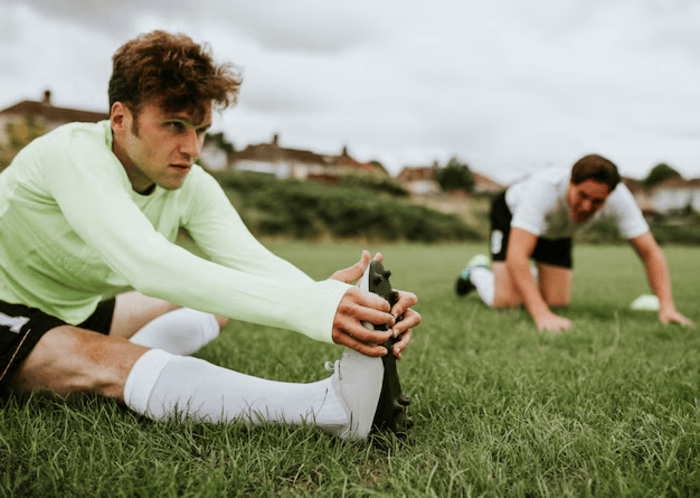Strength and Conditioning for Soccer Players: The Ultimate Workout Guide
The game requires speed-based explosive movements and endurance activities requiring accurate agility movements to excel. Contemporary soccer demands more than skillful play because physical conditioning is the main factor that separates average athletes from those who make exceptional achievements.
Laboratory-tested strength and conditioning techniques lead to optimal pitch performance of amateur and professional soccer players.

Performance Enhancement Through Power Training
Each soccer match includes sudden, explosive actions. The game can be decided by how much success you achieve when taking your first few steps to avoid defenders or when jumping for a header. Training techniques unique to power development exceed essential strength work that should be used to develop this attribute.
To develop strength, nerve cells meet muscle tissue at the neuromuscular junction. Plyometric and ballistic exercises during training accelerate the neuromuscular junction, resulting in rapid explosive muscle contractions.
Thanks to the Melbet APK download, tracking athletes’ performance and adequately building a betting strategy is possible. Olympic lifts performed technically correctly will significantly increase your force generation rate, creating stronger sprinting and jumping abilities during competition.
Recovery Optimization Techniques
The recovery process needs more than rest because it determines your athletic training adjustment capability. According to athletes who have mastered advanced athletic techniques, recovery is essential for performance enhancement.
- The recovery strategy requires proper hydration as its first step, followed by appropriate nutrition scheduling for optimal adaptation. TOP sleep quality delivers more recovery benefits than duration does.
- A recovery kit requires compression wear to reduce swelling, alternating hot and cold therapy, and specific self-foam roller techniques for massage.
Such methods should be implemented between practice sessions to sustain peak performance throughout the competitive season.
Specialized Training Methodologies
The specific physical attributes needed for each field position differ according to position. Confidently identifying required physical demands from your position enables you to focus training on activities that boost in-game effectiveness.
Midfield Conditioning Systems
The activity required of a midfielder exceeds other soccer positions because they run distances up to 7-9 miles during matches.
Professional player movements analyzed through the platform Melbet Sri Lanka guide the development of training programs. Players must engage in methodical training that spans different periods to construct this enduring foundation.
The cardiovascular foundation that a midfielder needs results directly from training within defined heart rate zones. Mission-critical cellular energy systems known as mitochondria develop through exercising at Zone 2, which operates between 60-70% of one’s maximum heart rate.
The proper training approach includes game simulation interval work, which employs sixty-second intense bursts mixed with two-minute active recovery sessions to match real game work-to-rest activities. Your exercise periods develop lactate clearance abilities so you can perform better as others start to wane toward the end of games.

Defensive Strength Frameworks
Successful physical duels in matches require defenders to possess functional strength capabilities, enabling them to dominate while retaining their quick movements across the field. Bodybuilding programs produce large muscles that do not perform optimistically during matches.
To compete against forwards, players need core anti-rotation exercises that improve stabilizing strength. Body strength from the lower regions requires eccentric control, which can be developed using tempo squats and Romanian deadlifts.
Defenders who develop eccentric strength demonstrate better stability during a fast change of direction since it stops the body from collapsing, thus lowering injury risks and strengthening performance.
Preventative Training Protocols
Moving dynamically in soccer subjects the body to high levels of stress. Lie prevention methods help reduce injuries, which prolong athletic career time.
The ankle-knee-hip chain operates as a united unit since weakness in any portion creates risks of injury for the entire system. Combining suitable movement patterns with evenly developed strength enables athletes to resist typical soccer-related injuries.
Unilateral stability training should be the priority since soccer injuries primarily happen when athletes move with only one leg. Protective strength against injuries on the field emerges from exercising with step-downs, single-leg Romanian deadlifts, and lateral lunges.
Seasonal Training Architecture
The strategic organization of training intensity produces its best results during critical competition situations. The technique of random training results in random performance levels, but organized periodization training brings about steady progress.
Skilled athletes view training as something that lasts over time. Strength development occurs first in the off-season before athletes transform this base into explosive power during the pre-season while maintaining both qualities with reduced effective dosages during competition times.
The planning system leads to performance prevention from burnout and peak performance optimized for significant competitions. Your body should determine when the most beneficial training choice demands taking an additional rest day instead of continuing through weariness.





